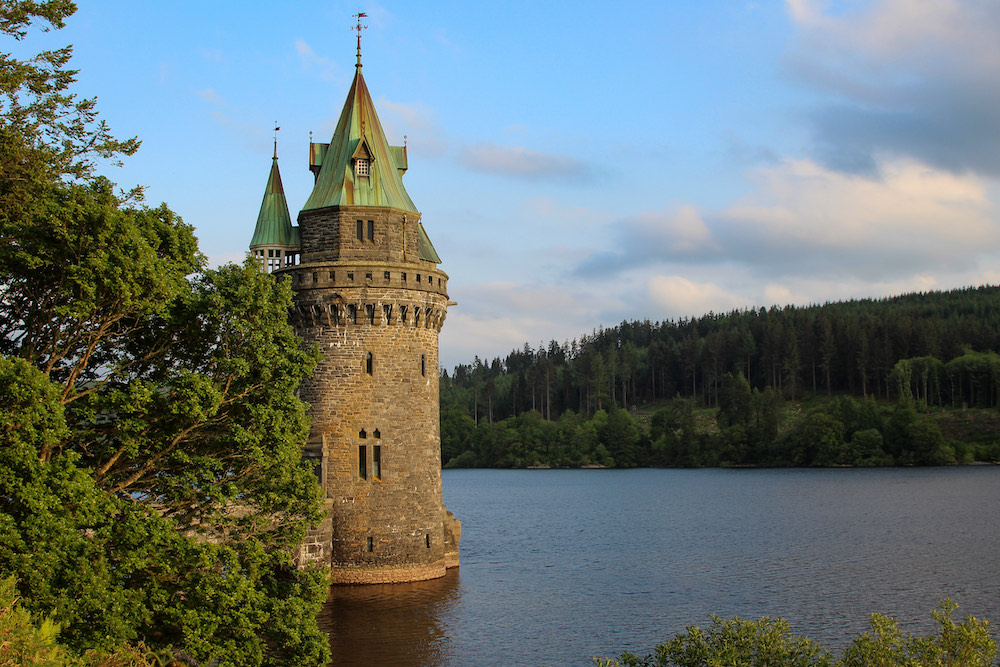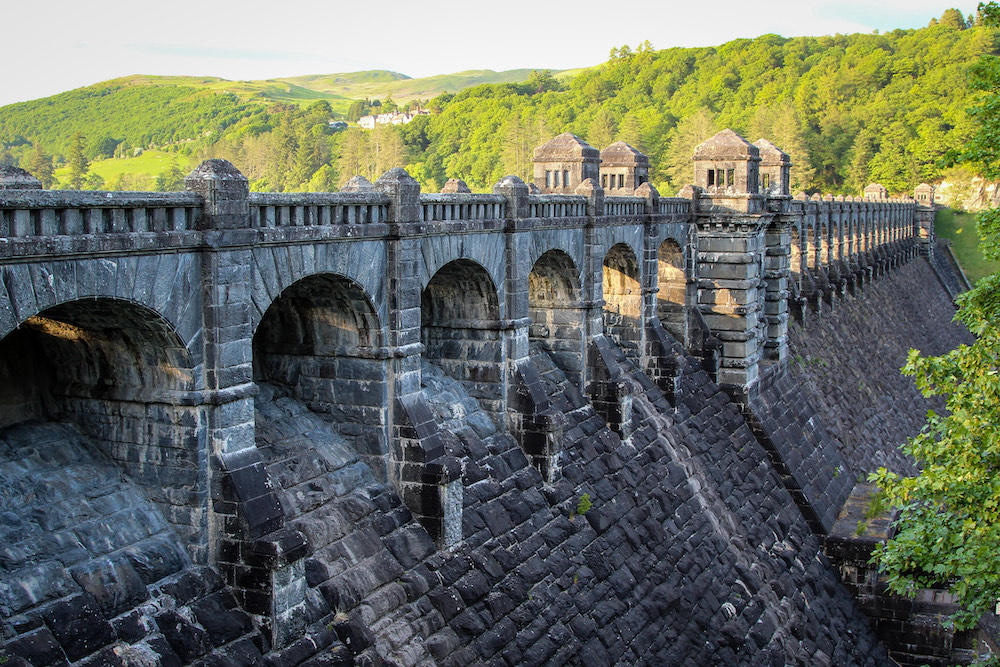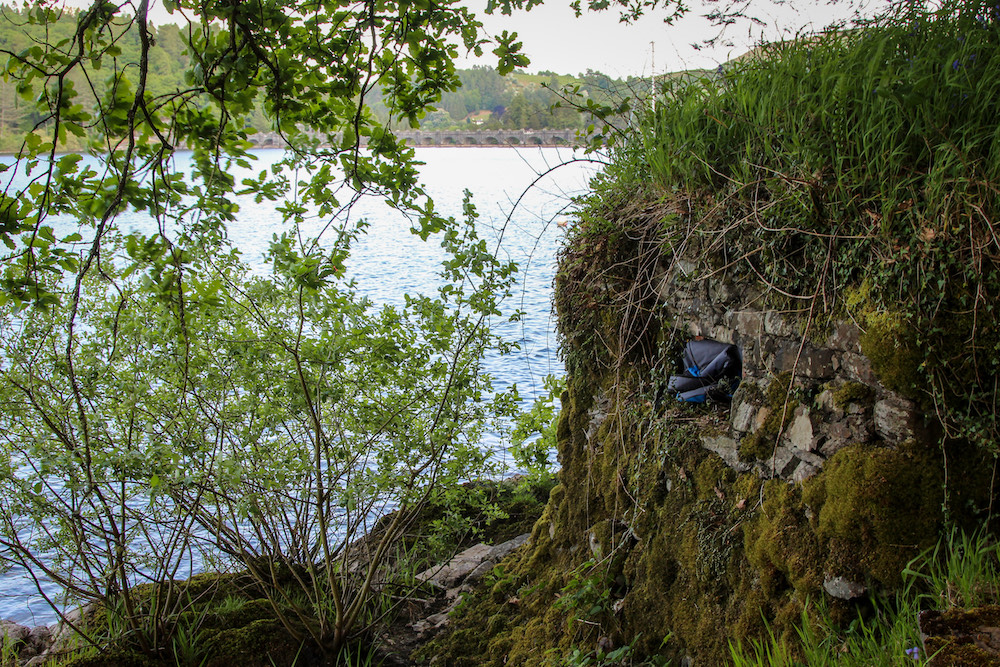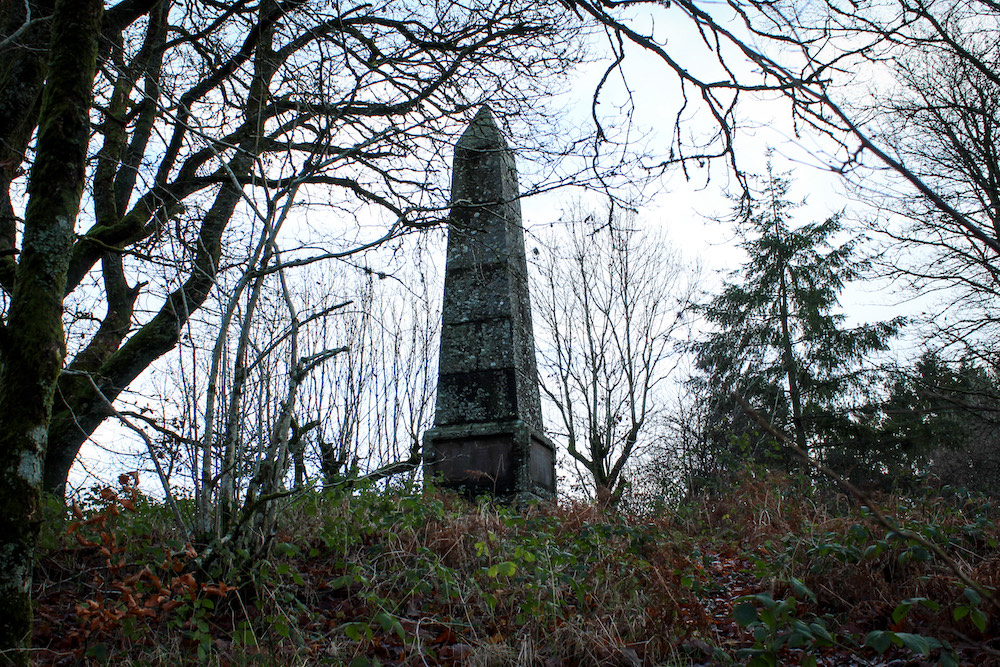Letter from Llyn Llanwddyn

Aled Morgan Hughes
It’s Sunday evening and the bank holiday crowds have eased somewhat. At one end of the dam a pair of grey-haired, leather-kitted bikers painstakingly position their motorbikes for the perfect photo-op.
Further along the dam a family bounce from one side to the other searching for the perfect selfie, their Midlands accents echoing along the 358 metres of grey granite.
Their Instagram and Facebook feeds will soon reference “Lake Vyrnwy” – a brave few even attempting the Welsh “Llyn Efyrnwy”. However, for me, like so many other locals it will always be Llyn Llanwddyn.

Memories
Few places in Wales are so deeply entwined to my identity as here. As a child, I’d often make the short journey up to the reservoir with Taid from the village below – himself a former gauge keeper on the dam for decades.
Whilst at Ysgol Gynradd, we’d do a sponsored cycle along the dam – it felt so much bigger back then. Meanwhile, since moving away, it’s become somewhat of a shrine for reflection, or go-to destination in attempts to (unsuccessfully) woo a love interest.
Even as a wide-eyed political candidate, it was a no-brainer that my first leaflet would be adorned by my portrait besides the iconic gothic straining tower and lake.
It’s not just political leaflets, either. From news reports to newspaper columns and more, Llyn Llanwddyn has become the visual embodiment not only of Mid Wales, but also the continued struggle within the Welsh consciousness around the politics of water.
There’s a beauty here, without doubt, but also an air of haunting falseness – “an unnatural shadow” as observed by T.I. Ellis. Indeed, the steep hills, evergreen trees, glistening lake and ski-resort style hotel, often seem more Alpine than Mid Wales.

Drowning
It wasn’t always like this. Strip back the millions of gallons of water, and below lie the remains of ‘old’ Llanwddyn – its 2 chapels, 3 pubs, 37 houses and 10 farmsteads.
With Liverpool’s population booming by the late nineteenth century, more water was needed; and soon Llanwddyn and the Vyrnwy Valley would become the answer. An 1880 Parliamentary Bill saw plans rubber-stamped to form the largest artificial reservoir in Europe here – an unprecedented architectural feat.
Unbelievably, at its height, a thousand men worked in this sleepy corner of Montgomeryshire – labouring around the clock over the coming decade to complete the work, with water flowing over the lip of the dam for the first time in 1889.
As with Tryweryn decades after, little consideration was given to the villagers; un-consulted throughout, they were left with no choice but being rehoused downstream – their ancestors exhumed and reburied nearby.
For over a century water has flowed from this reservoir, lining the pockets of water companies, whilst the community, and Wales loses out.
Even today, barmy proposals are afoot to redistribute this very water to the Thames basin – aiding those water companies seemingly more determined to transfer water across the country than fixing their own leaks and failings.
Decline
It’s not just the water flowing from Llanwddyn either; it’s the young people, too.
It’s complex, of course – but other than the hotel and farmsteads, employment opportunities are few and far between, whilst the housing crisis continues to bite.
Most have no choice but to leave – some to nearby Oswestry or Welshpool, others further afield to distant towns and cities.
The village school closed for the last time in 2009, meanwhile, at Wddyn Park – home to the village’s once formidable football team – the grass grows long, with the club folding in 2019, citing a shortage of players.
Inevitably, the Welsh language is in retreat here, too. In 2001, 47.5% of the ward could speak, read or write in Welsh – by 2021 it had dropped to 40%.
It’s not all decline of course; the remaining community – a patchwork of those who have moved in and longstanding old families – work hard to maintain the community hall, hosting an array of social events.
Frontier
Societal change and conflict are nothing new here. As in so many places across Montgomeryshire, this is the frontier where west Wales meets east – where Y Fro Gymraeg encroaches British Wales.
Oral traditions of Glyndŵr’s soldiers traversing the nearby valleys continue to this day. Meanwhile some historians wager the now murky depths of the lake witnessed the Battle of Vyrnwy (1400) between Glyndŵr’s men and Henry IV’s English – bringing the first chapter of his revolt to an end.
It’s not just medieval battles either. Study the lake’s banks close enough and you may spot the remains of a Second World War machinegun pillbox.
Whilst the Allies’ Dambusters targeted German Ruhr reservoirs, a fear of Axis retaliation against Vyrnwy was rife.
This was furthered by Nazi agitator Lord Haw-Haw’s haunting radio threats – “The roads of Meifod are narrow but will soon be widened by the waters of Lake Vyrnwy“.
Thankfully, no bomb fell on the camouflaged lake during wartime – the closest, a rogue explosion near Llanfyllin, several miles away.

Remains
Rarely – to a furore of media attention and misinformation – the lake’s waters dare retreat to reveal the ghostly remains of the Vyrnwy Valley – a bridge, and old road and some ruins.
During last year’s drought, a British media frenzy heralded the return of the “lost”, “hidden” and “forgotten” village; as if its disappearance was disregarded as some romanticized Welsh Atlantis – rather than the orchestrated drowning of a living, breathing community.
Hidden amidst the undergrowth on a cliff high above the dam, another relic from the drowning stands. A now neglected obelisk towers through the bracken – commemorating the 44 workers who died during the course of the works– 10 killed on site – their names slowly fading into obscurity.
Forget the lake, that alpine view, the picnic tables and shiny dam-side plaques documenting Royal visits. For me, it’s this crumbling piece of granite that embodies the true Llanwddyn.
It is a place of unrivalled beauty, yes, but also haunted by a century-old shadow of crippling loss, exploitation and decline – hidden so very clearly in plain sight.
Enjoy more ‘Letters from‘ by following the links on this map
Support our Nation today
For the price of a cup of coffee a month you can help us create an independent, not-for-profit, national news service for the people of Wales, by the people of Wales.





I pulled a body out of Llyn Llanwddyn years ago but I was acting in a film and the ‘body’ was a stuntman wearing a wet suit, for the life of me I can’t remember the name of the film…
A long time friend had the old school below the dam where he kept his collection of cars, boats. wind machines and anything else you could name. He must be ancient by now, I hope he is still with us…
Haw Haw never went near Meifod, it has one of the widest thoroughfares, you can get twenty cows abreast easy…
An interesting read. Llanwddyn did at least fare better than Capel Celyn (it annoys me how few people seem to know the name of the village itself) in being rebuilt as a unit. Although reprehensible and inexcusable in the way it acted, Liverpool was materially no different from Cardiff in how it submerged communities. Swansea tried the same on Llangyndeyrn but the residents managed to convince them to locate it elsewhere. The use of Welsh reservoirs holding back water the would ultimately flow into England is contentious, but if it’s for use within a natural catchment area then it’s understandable… Read more »